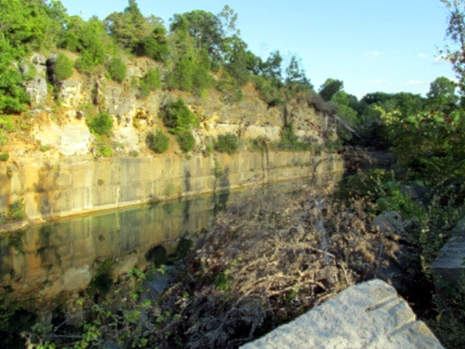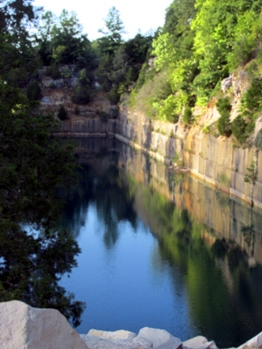Bloomington is a city the southern region of the U.S. state of Indiana. The city has a population of roughly 80,000 and is the county seat of Monroe County. It is just 45 miles (72km) southwest of Indianapolis and considered the liveliest small city in Indiana, mainly due to its relatively large student population. Surrounded by rocky limestone outcrops, Bloomington is home to the Indiana University Bloomington campus, the flagship institution of the Indiana University system. Indiana University is a "Public Ivy" university and the Bloomington campus has over 40,000 students, making it the state’s largest university. Quarrying of the surrounding limestone deposits spurred along Bloomington’s growth in the 19th century, the results of which are seen today in many of its magnificent public buildings.

Above: Monroe County Courthouse
One of the finest buildings in the downtown area is the Beaux Arts Monroe County Courthouse at the centre of the Courthouse Square Historic District. The author of this webpage has three sources citing the date it was completed. One states in 1906, one states 1907 and according to Wikipedia, 1908 (answers via the contact form on this website please!). The building is the seat of government for Monroe County. Other historic places in and around the city (listed on the National Register of Historic Places) include a number of historic houses, several historic districts (Bloomington West Side, North Washington Street, Prospect Hill, Steele Dunning, University Courts, Vinegar Hill), a post office which has been in operation since 1825, Bloomington City Hall (1915), the Cantol Wax Company Building (c. 1906), a historic Coca-Cola Bottling Plant, Hinkle-Garton Farmstead (1892), the Home Laundry Company, Illinois Central Railroad Freight Depot, Johnson's Creamery, the Monroe Carnegie Library, Princess Theatre (built in 1892, expanded and converted into a theatre 1913 and refurbished to present appearance 1923), the Second Baptist Church, Seminary Square Park, the Wicks Building and the Woolery Stone Company.

Above: The Memorial Stadium, also known as The Rock - A stadium primarily used for football, it is the home field of the Indiana Hoosiers. It opened in 1960 as part of a new athletics area at the university, replacing the original Memorial Stadium (built in 1925), which was located where an arboretum now stands.
The Tibetan Cultural Center, located just southeast of the city, was founded in 1979 by Thubten Jigme Norbu, elder brother of the 14th Dalai Lama. It is the only one in the United States and is a very fine place for meditation. The city’s Kirkwood Avenue is lined with restaurants and bars down to the university’s Sample Gates entrance. Bloomington has been designated a Tree City for 32 years, as of 2015. Other points of interest in and around the city include the Bloomington Playwrights Project (BPP, a not-for-profit arts organization), Lake Lemon (approximately 10 miles/16km) to the northeast), and Indiana’s largest microbrewery, the Upland Brewing Company. The Monroe Lake State Recreation Area lies 4 miles (6km) to the southeast. As well as the university, the local economy is based on diversified industry, especially in the production of refrigerators, elevators, medical and surgical equipment, and televisions. Some more photos of the city and of the university campus can be seen in the thumbnail gallery below (click on an image to enlarge):
On the expansive and leafy university campus are a variety of both historic and more modern buildings, as well as some beautiful outdoor spaces. The Auditorium (1941) displays 40 panels of the American painter and muralist Thomas Hart Benton’s Century of Progress murals (1933), which were painted for the World’s Fair. The Indiana University Art Museum, designed by Chinese-American architect I.M. Pei (known for many structures including the Bank of China Tower in Hong Kong and the pyramid at the Louvre Museum in Paris), includes works by Henri Matisse, Claude Monet, Auguste Rodin, Rembrandt, Edgar Degas, Pablo Picasso, Jackson Pollock, and Andy Warhol. The Indiana University Art Museum is also home to a large collection of Mesoamerican, African, Asian and ancient Roman treasures. Nearby is the Lilly Library, which has a collection of rare books and manuscripts including an original 1450’s Gutenberg Bible and a 1480’s Canterbury Tales. As well as the university, Bloomington is also home to several other schools, institutes and the Indiana University Press.
Breaking Away
On a side note, Breaking Away is a 1979 American coming of age comedy-drama film. It was produced and directed by Peter Yates and written by Steve Tesich and follows a group of four high school graduate male teenagers in Bloomington. It stars Dennis Christopher, Dennis Quaid, Daniel Stern, Jackie Earle Haley, Barbara Barrie, Paul Dooley, and Robyn Douglass. Featuring a re-enactment of Indiana University's annual Little 500 bicycle race, Breaking Away won the 1979 Academy Award for Best Original Screenplay and received four other nominations. The scenes in the film were filmed in and around Bloomington including many on the Indiana University campus. One of the iconic scenes in the film is set in an old limestone quarry, which is located on a private property in Perry Township south of Bloomington. It is now generally referred to as the "Roof Top" quarry, but was originally known as "The Long Hole" or "Sanders" quarry. There is a review about the site’s significance in the film, written for the UK’s Guardian newspaper on the link Here. More information about the film may be found on IMDB Here and on Wikipedia Here. Two photos of the old limestone quarry are shown below:
 |
 |
On researching for this webpage (in December 2018), it was discovered that it is not possible to visit the quarry without permission from the landowner (the Indiana Limestone Company) and that in any event, the site has been made much more inaccessible. Three people have died in the past 25 years after jumping from the quarry’s 65 foot (20m) high ledges. The gigantic hole left in the ground used in the film has reportedly recently been filled in due to safety concerns about people jumping in (article on external webpage Here). That said, this seems a matter of debate (see external webpage Here). The company owns a chain of quarries in southern Monroe County, where limestone for New York City’s Empire State Building, the Rockefeller Center, and many other notable buildings across the United States has been quarried. In short, it is not recommended to attempt to access the quarry and definitely a really bad idea to jump into the water, assuming it is still there at all.
Back to Top